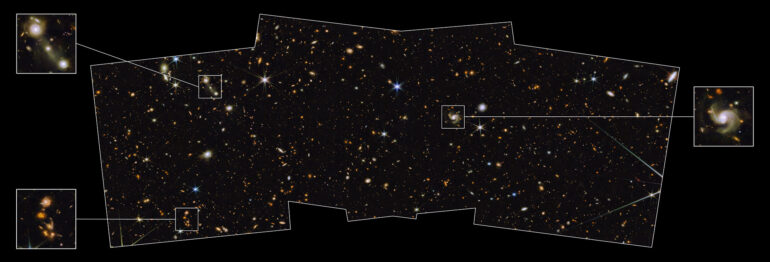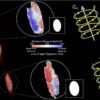NASA’s James Webb Space Telescope has captured one of the first medium-deep wide-field images of the cosmos, featuring a region of the sky known as the North Ecliptic Pole. The image, which accompanies a paper published in The Astronomical Journal, is from the Prime Extragalactic Areas for Reionization and Lensing Science (PEARLS) GTO program.
“Medium-deep” refers to the faintest objects that can be seen in this image, which are about 29th magnitude (1 billion times fainter than what can be seen with the unaided eye), while “wide-field” refers to the total area that will be covered by the program, about one-twelfth the area of the full moon.
The image includes eight different colors of near-infrared light captured by Webb’s Near-Infrared Camera (NIRCam), augmented with three colors of ultraviolet and visible light from the Hubble Space Telescope. This beautiful color image unveils in unprecedented detail and to exquisite depth a universe full of galaxies to the furthest reaches, many of which were previously unseen by Hubble or the largest ground-based telescopes, as well as an assortment of stars within our own Milky Way galaxy.
The NIRCam observations will be combined with spectra obtained with Webb’s Near-Infrared Imager and Slitless Spectrograph (NIRISS), allowing the team to search for faint objects with spectral emission lines, which can be used to estimate their distances more accurately.
Members of the PEARLS team that created this image shared their thoughts and reactions while analyzing this field.
“For over two decades, I’ve worked with a large international team of scientists to prepare our Webb science program,” said Rogier Windhorst, Regents Professor at Arizona State University (ASU) and PEARLS principal investigator. “Webb’s images are truly phenomenal, really beyond my wildest dreams. They allow me to measure the number density of galaxies shining to very faint infrared limits and the total amount of light they produce.”
“I was blown away by the first PEARLS images,” agreed Rolf Jansen, Research Scientist at ASU and a PEARLS co-investigator. “Little did I know, when I selected this field near the North Ecliptic Pole, that it would yield such a treasure trove of distant galaxies, and that we would get direct clues about the processes by which galaxies assemble and grow. I can see streams, tails, shells, and halos of stars in their outskirts, the leftovers of their building blocks.”
“The Webb images far exceed what we expected from my simulations in the months prior to the first science observations,” said Jake Summers, a research assistant at ASU. “Looking at them, I was most surprised by the exquisite resolution. There are many objects that I never thought we would actually be able to see, including individual globular clusters around distant elliptical galaxies, knots of star formation within spiral galaxies, and thousands of faint galaxies in the background.”
“The diffuse light that I measured in front of and behind stars and galaxies has cosmological significance, encoding the history of the universe,” said Rosalia O’Brien, a graduate research assistant at ASU. “I feel very lucky to start my career right now. Webb’s data is like nothing we have ever seen, and I’m really excited about the opportunities and challenges it offers.”
“I spent many years designing the tools to find and accurately measure the brightnesses of all objects in the new Webb PEARLS images, and to separate foreground stars from distant galaxies,” says Seth Cohen, a research scientist at ASU and a PEARLS co-investigator. “The telescope’s performance, especially at the shortest near-infrared wavelengths, has exceeded all my expectations, and allowed for unplanned discoveries.”
“The stunning image quality of Webb is truly out of this world,” agreed Anton Koekemoer, research astronomer at STScI, who assembled the PEARLS images into very large mosaics. “To catch a glimpse of very rare galaxies at the dawn of cosmic time, we need deep imaging over a large area, which this PEARLS field provides.”
“I hope that this field will be monitored throughout the Webb mission, to reveal objects that move, vary in brightness, or briefly flare up,” said Jansen.
Koekemoer added, “Such monitoring will enable the discovery of time-variable objects like distant exploding supernovae and bright accretion gas around black holes in active galaxies, which should be detectable to larger distances than ever before.”
“This unique field is designed to be observable with Webb 365 days per year, so its time-domain legacy, area covered, and depth reached can only get better with time,” concluded Rogier.
More information:
Rogier A. Windhorst et al, JWST PEARLS. Prime Extragalactic Areas for Reionization and Lensing Science: Project Overview and First Results, The Astronomical Journal (2022). DOI: 10.3847/1538-3881/aca163
Provided by
Webb Space Telescope
Citation:
Webb glimpses field of extragalactic PEARLS, studded with galactic diamonds (2022, December 14)



